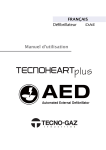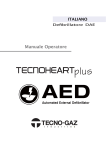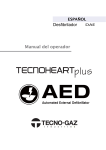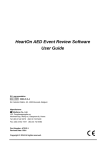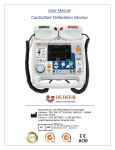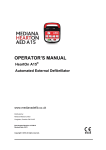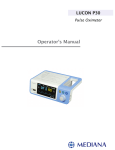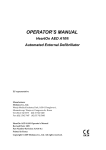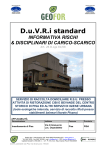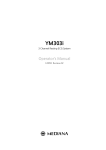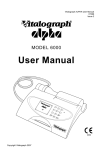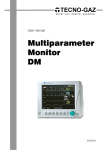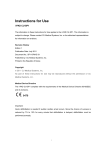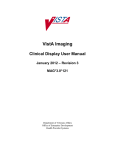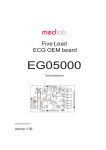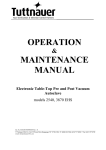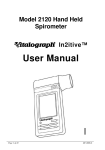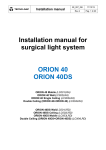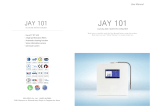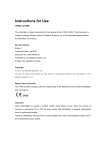Download User Manual Defibrillator - Tecno-Gaz
Transcript
ENGLISH Defibrillatore DAE Defibrillator User Manual EU Representative OBELIS S.A Bd. Général Wahis, 53, 1030 Brussels, Belgium Manufacturer MEDIANA Co., Ltd. 132, Donghwagongdan-ro, Munmak-eup, Wonju-si, Gangwon-do, Korea Tel: (82) 2 542 3375 (82) 33 742 5400 Fax: (82) 2 542 7447 (82) 33 742 5483 Sold in Private Label by TECNO-GAZ S.p.A. a single-member company Strada Cavalli n.4 – 43038 – Sala Baganza – Parma – Italy Tel. +39 0521 8380 Fax: +39 0521 833391 Manual code: 0Z12I0008 Edition 0 on date: 2014-09-18 Copyright © 2014 All rights reserved. Directive The Copyright law does not allow the total or partial reproduction of this instructions manual without prior authorisation. The contents of this manual are subject to change and modification without forewarning. The data contained in this manual are considered correct. In case of objectionable content, please contact our assistance centre. The manual will be subject to review if any pages are missing or in the wrong order. Warranty Any faults or damage affecting the device caused by the following situations during the warranty period are not covered by this warranty: Installation, installation due to relocation, maintenance and repairs carried out by staff or technicians that are not authorised by TECNO-GAZ. Damage to TECNO-GAZ products caused by the use of products of other companies, with the exception of products delivered by TECNO-GAZ. Damage – caused by unsuitable and/or improper use – is the responsibility of the user. The use of parts for maintenance that are not recommended by TECNO-GAZ, for repairs and maintenance. Changes to the device or the use of accessories that are not specifically recommended by TECNO-GAZ. Damage caused by accidents or natural calamities (earthquakes, floods, etc.). Damage due to the failure to observe the warnings and instructions for use set forth in this manual. Damage due to the failure to observe the recommended maintenance checks. This warranty only covers parts. The warranty does not cover the following cases: Any damage or leaks due to the connection or operation of accessories. In case of product defects, we ask that you contact our sales point or the EU representative, as stated on the back cover. TECNOHEART plus complies with EMC standard IEC60601-1-2 Notes: Use near mobile phones could cause faulty function of the AED. History of the Revisions The document part number and the revision number identify the current version. The revision number changes when a new version is printed, in compliance with the history of the revisions of the documentation. The revision number does not change with minor corrections and updates that are added in the re-prints. The number for the document part changes when considerable technical changes are added. Factory Brand It is likely that the trade names of the product provided herein are brands or registered brands of the involved company. CONTENTS CONTENTS ................................................................................................................................... i SAFETY WARNINGS ................................................................................................................... 1 General Safety Warnings ...................................................................................................................... 1 Warnings ............................................................................................................................................... 1 Attention: ............................................................................................................................................... 3 INTRODUCTION .......................................................................................................................... 5 Intended use of the AED ....................................................................................................................... 5 Information on the Manual..................................................................................................................... 6 Identifying the AED Configurations ....................................................................................................... 6 DESCRIPTION OF THE AED ....................................................................................................... 7 Parts of the Top and Right Panel........................................................................................................... 7 Parts of the Rear Panel ......................................................................................................................... 8 Symbols and Labels .............................................................................................................................. 9 CONFIGURING THE AED .......................................................................................................... 11 Unpacking and inspection ................................................................................................................... 11 Parts List.............................................................................................................................................. 11 Soft case.............................................................................................................................................. 12 • SD card ............................................................................................................................................. 12 Infrared communication port:............................................................................................................... 12 Configuring the AED ............................................................................................................................ 13 Temperature status .............................................................................................................................. 13 Installation step 2................................................................................................................................. 14 Installation step 3................................................................................................................................. 14 Installation step 4................................................................................................................................. 14 BATTERY OPERATION ............................................................................................................. 15 Battery-run AED Operation.................................................................................................................. 15 How the change the battery ................................................................................................................ 15 Battery Status Reading ....................................................................................................................... 17 Self-test ............................................................................................................................................... 18 Running the Power On Self-Test (POST) ............................................................................................ 18 Automatic Self-test .............................................................................................................................. 18 Self-test when the Batteries are Inserted ............................................................................................ 19 AED OPERATION ...................................................................................................................... 21 AHA 2010 guidelines for CPR and ECC ............................................................................................. 21 Additional amendments to the AHA 2010 guidelines for CPR and ECC ............................................. 21 2010 CPR GUIDELINES ..................................................................................................................... 22 Pre-defibrillation Action........................................................................................................................ 23 Turn the AED on .................................................................................................................................. 23 TECNOHEART plus operation ............................................................................................................ 24 AHA 2010 provisions ........................................................................................................................... 26 Notes on how to perform CPR ............................................................................................................ 27 Notes on User and Bystander Safety (anyone surrounding the rescuer and the patient) .................. 27 MAINTENANCE ......................................................................................................................... 29 Recycling and Disposal ....................................................................................................................... 30 Returning the AED and System Parts ................................................................................................. 31 Assistance ........................................................................................................................................... 31 Periodic Safety Checks ....................................................................................................................... 31 CLEANING .......................................................................................................................................... 31 Battery Maintenance ........................................................................................................................... 31 Electrode Maintenance ........................................................................................................................ 31 Replacing the Electrodes .................................................................................................................... 31 AED Maintenance................................................................................................................................ 32 TROUBLESHOOTING ............................................................................................................... 33 General ................................................................................................................................................ 33 Corrective Measures ........................................................................................................................... 33 EMI (Electromagnetic Interference)..................................................................................................... 34 Obtaining Technical Assistance ........................................................................................................... 34 GLOSSARY ................................................................................................................................ 35 TECHNICAL SPECIFICATIONS ................................................................................................ 37 Conformity ........................................................................................................................................... 42 Manufacturer declaration ..................................................................................................................... 45 i ILLUSTRATIONS Figure 1. TECNOHEART plus .................................................................................................... 7 Figure 2. TECNOHEART plus: Parts of the Top and Right Panel ......................................... 7 Figure 3. Parts of the Rear Panel ........................................................................................... 8 Figure 4. Changing the handle/battery -Right panel .............................................................. 15 Figure 5. Changing the handle/battery -Top Panel ................................................................. 16 Figure 6. Patient mode switch ................................................................................................. 24 Figure 7. TECNOHEART plus: Action icon – Step 1 ............................................................ 24 Figure 8. Placement of electrodes ........................................................................................... 24 Figure 9. TECNOHEART plus: Disconnect icon of the electrodes ....................................... 24 Figure 10. TECNOHEART plus: Icon of Action - Phase 2 ................................................... 25 Figure 11. DAE: Icon of Action - Phase 3 ............................................................................. 25 Figure 12. TECNOHEART plus: Icon of Action - Phase 4 ................................................... 26 Figure 13. Date of expiry of the electrodes ........................................................................... 32 TABLES Table 1. Parts of the Top and Right Panel .............................................................................. 8 Table 2. Symbols used on the Panel and Labels .................................................................... 9 Table 3. Accessories ................................................................................................................. 11 Table 4. Battery Status Icon ..................................................................................................... 17 Table 5. Electromagnetic emissions (IEC60601-1-2) ............................................................... 45 Table 6. Electromagnetic Immunity (IEC60601-1-2) ................................................................ 45 Table 7. Electromagnetic Immunity (IEC60601-1-2) (continued from previous page) .......... 46 Table 8. Recommended Safety Distances ............................................................................... 47 Table 9. Cables (IEC60601-1-2) ............................................................................................... 47 ii SAFETY WARNINGS General Safety Warnings This section contains important safety warnings regarding the general use of TECNOHEART plus. Additional safety warnings are provided inside this manual. In the manual, TECNOHEART plus will be referred to as AED Read the operator manual carefully before use, as well as any additional instructions for use, and all of the information and precautionary specifications. Warnings Warnings are identified by the WARNING symbol displayed above The warnings identify the danger of potentially dangerous situations (death, injury or adverse events), damaging the patient or the user. WARNING: It is essential that all of the users of an AED notify TECNO-GAZ of any accidents when the AED is suspected of having caused death, serious injury or disease. If you have any concerns that a similar case has occurred, you are required to notify TECNO-GAZ directly or through your authorised TECNO-GAZ supplier. WARNING: The AED must be used by staff trained in CPR manoeuvres and AED use. The qualifications for use of the AED must follow local legislation. WARNING: The AED can deliver therapeutic electrical shocks. The shock can cause serious damage to the operator as well as to bystanders. It is necessary to be very careful that neither operator nor bystander touch the AED when a shock is about to be delivered. WARNING: The AED was not designed or approved for use in dangerous areas as specified in the American National Electrical Code (Articles 500-503). In fulfilment of the requirements of the IEC/EN 60601-1 classifications, the AED must not be used in the presence of flammable substances/air mixtures. WARNING: The AED was designed to operate on unconscious patients, who are not breathing and do not have a heartbeat*. If the patient is conscious or breathing and their heartbeat starts up again, do not use the AED. (*health care staff is in charge of monitoring the heat beat) WARNING: Touching the patient during the treatment analysis phase may cause interference with the diagnostic process. Avoid contact with the patient and keep him/her as still as possible while running the ECG. The AED will tell you when it is safe to touch the patient. WARNING: Keep your distance from the patient during treatment. The defibrillation energy delivered to the patient could be conducted through the patient's body and cause a lethal shock to anyone touching the patient. WARNING: It has been determined that the use of the AED is safe when used in combination with oxygen delivery systems, through masks. Nonetheless, due to the risk of explosion, it is strongly recommended not to use the AED near explosive gases. This includes flammable anaesthetics, concentrated oxygen and petrol. WARNING: The same electrodes can be used on Adult and Paediatric patients. Adult mode must be used on patients that are 8 years of age or older. Paediatric mode must be used on patients who are under 8 years of age or who weigh less than 25 kg (55lb). 1 Do not use the AED on patients who are under 1 year of age. WARNING: Correct electrode positioning is crucial. It is essential to follow the electrode positioning instructions carefully, provided on the labels and during training. It is necessary to make sure that the electrodes adhere well to the patient's skin. It is necessary to eliminate any air pockets between the electrode and the skin. If the electrodes fail to adhere well to the skin, this could affect the effectiveness of the therapy or cause excessive lesions on the patient's skin when an electrical shock is delivered. It is normal for the skin to redden following treatment. WARNING: The AED battery is not rechargeable. Do not attempt to recharge, open, crush or burn the battery, as it could explode or catch fire. WARNING: Keep the electrodes from coming into contact with other electrodes or metal parts that are touching the patient. This contact could cause burns to the patient's skin during defibrillation and could divert the defibrillation current away from the heart. WARNING: Be careful of any possible contact with the conductive part of the electrode, the connector line, the connectors for cables, or any other parts applied to the patient, for the safety of the patient him/herself. WARNING: Do not use the unit near or inside pools of water. WARNING: Do not re-use the electrodes on multiple patients. WARNING: Only use the AED or the accessories according to the methods described in this manual. Improper use of the AED can cause death or injury. WARNING: DO NOT USE OR ACTIVATE THE AED IF THE STATUS INDICATOR READS "X". WARNING: Keep the batteries dry and away from sources of heat (including direct sunlight). If there is any visible damage or loss, prevent the liquid from coming into contact with your skin or eyes. If there has been contact, rinse the affected part abundantly with water and immediately seek medical attention. WARNING: The AED is equipped with an automatic device to deactivate accumulated energy. If the operator has not released the energy on the patient, an internal timer will deactivate the accumulated energy. Accumulated energy can cause death or injury if discharged improperly. Follow the instructions provided herein. 2 Attention: Situations of alert are marked by the ATTENTION symbol illustrated above. Attention signs identify conditions or actions that could cause damage to the equipment or to property. ATTENTION: The AED may not operate correctly if it is activated or stored in conditions that differ from those set forth herein ATTENTION: The AED is resistant and reliable in various conditions of use. Nonetheless, an overly aggressive AED treatment can cause damage to the unit or the accessories, causing the warranty to lapse. Check the AED and its accessories for any damage, on a regular basis and based on the instructions. ATTENTION: Before delivering a shock, it is important to disconnect the patient from other electrical medical equipment, such as blood flow meters, that may not be equipped with protection from defibrillators. Also make sure that the electrodes are not touching metal objects such as bed frames or tensioners. ATTENTION: Only remove the protective film from the cartridge when you are ready to use the electrodes. ATTENTION: Do not use or activate the AED before reading the Operator Manual for the AED. ATTENTION: Do not use the AED or connect it to other equipment. If the AED is used with or connected to other equipment, check operation carefully prior to use. ATTENTION: Treating or transporting the patient during the ECG analysis could cause interference with the diagnostic process, which could prolong analysis times. If the AED reads SCARICA CONSIGLIATA (SHOCK RECOMMENDED) during treatment or transport, stop the device and keep the patient as still as possible for at least 15 seconds before pressing the Scarica (shock) button, so that the AED can re-confirm the analysis of the heartbeat ATTENTION: It is necessary to perform periodic checks on this device to ensure, among other things, that the AED is not damaged in any way. ATTENTION: The electrodes are a single-use accessory and must be replaced after every use or if the electrodes are broken/compromised in any way. If you suspect any damage, the electrodes need to be replaced immediately. ATTENTION: Do not use training electrodes with this AED ATTENTION: Be particularly careful with patients with pacemakers. To determine whether there is a pacemaker, it is necessary to run a physical exam and study the patient's medical history. In patients with pacemakers, the AED could have less sensitivity and may not detect all of the rhythms required for defibrillation. ATTENTION: If the electrodes adhere well to the patient's chest, the AED can analyse the precise ECG and avoid burns to the skin. If, however, the electrodes overlap on the patient's chest, they will not deliver the defibrillation energy correctly. Page left intentionally bla nk. 3 4 INTRODUCTION TECNO-GAZ offers a completely configurable AED designed to actuate the suitable protocol in case of sudden cardiac arrest (SCA). The current AED is designed to operate in compliance with the 2010 version of the guidelines established by the AHA/ERC regarding Cardiopulmonary Resuscitation (CPR) and Emergency Cardiovascular Care (ECC). It is recommended to be trained in the appropriate version of the AHA/ERC guidelines and the use of your AED configuration. For further information contact TECNO-GAZ or your authorised TECNO-GAZ distributor. Intended use of the AED The AED is intended to be used to treat someone who is unresponsive, non-breathing and pulseless for the adult and pediatric in all area of a hospital, pre-hospital, public access, alternate care and home healthcare environment. AED is designed to easy to use. Note: The intended patient populations are adult and pediatric (1-8 years old or less than 25 kg (55lb)) can be treated with the appropriate pads. Note: If you have concerns about your health or an existing medical condition, talk t o your doctor. A defibrillator is not a replacement for seeking medical care. Where can it be used? The intended environment to use the AED includes home healthcare, public space and hospital. The public space is a social space that is generally open and accessible to people. Roads (including the pavement), public squares, parks, subway station, government buildings, beaches, public libraries, privately owned buildings or property opened to public/visible from sidewalks and any shared spaces of automobiles and other vehicles are typically considered public space. Hospital use typically includes areas such as general care floors, operating rooms, special procedure areas, intensive and critical care areas within the hospital. Hospital-type facilities include physician office-based facilities, sleep labs, skilled nursing facilities, surgical centers, and sub-acute care centers. Who can use it? You cannot use the AED to treat yourself. The AED talks the user through each step of treating someone who is in SCA. However, anyone who might use the AED should review the training materials that come with it or contact your local authorized supplier or Medical technical support, and should be trained in cardiopulmonary resuscitation (CPR). Responding to SCA may require the user to kneel. Local Requirements Check with your state health department to see if there are any local or state requirements about owning and using an AED. You can find contact local supplier or Mediana technical support for learning about your country or state. Device Tracking This AED may be subject to tracking requirements by the manufacturer and distributors per local regulation. If there are tracking requirements in your local, please notify your local distributor when the AED has been sold, donated, lost, stolen, exported, or destroyed. 5 Information on the Manual This manual explains how to assemble and use the AED. Read the entire manual including the Safety Warnings section before using the AED. Identifying the AED Configurations This table contains the AED configurations and their names. The Reference number and the serial number can be found based on the AED. Configuration TECNOHEART plus Reference N. AE001Z12 Description Standard AED (4 action icons) Note: The alphabet “E” can be added as the last digit of reference number in accor dance with the region. Features for the AED Physical/Mechanical The AED is an automated external defibrillator (AED) used for the fast delivery of defibrillation electric shock therapy which can be battery-operated. Electrical The AED has an internal battery which is the non-rechargeable battery. Display The indication is LED indicator that flashes red LED under the relevant action icon. Auxiliary Input/Output(s) The AED provides Infrared communication port, SD card ports. 6 DESCRIPTION OF THE AED Parts of the Top and Right Panel 10 2 1 7 Figure 1. TECNOHEART plus 1 2 3 4 5 6 8 7 9 Figure 2. TECNOHEART plus: Parts of the Top and Right Panel 7 Table 1. Parts of the Top and Right Panel The cover is designed to protect the action icons, patient mode button and shock button. 1 Cover 2 Status indicator The status indicator indicates the status of the unit, the temperature and the battery level. 3 Electrode connector The electrode connector is used to connect the electrodes. 4 Action Icons The LED indicator flashes red under the corresponding action icon. 5 Patient mode switch Once the user has identified the patient based on type, select patient mode between adult or paediatric patient using the mode switch. 6 Shock Button Once preparation for the electric shock is completed, the current shock button will flash. Press the current Shock button to deliver the shock. 7 Scrolling button The scrolling button opens the cover, to turn on push the scrolling button to the right. 8 SD card slot The SD card is required to save data and update AED firmware. 9 Infra-red communication port The infra-red communication port is used to communicate with the PC. 10 Handle Battery AED Handle and Battery Parts of the Rear Panel 1 2 1. Handle/Battery 2. Battery removal button Figure 3. Parts of the Rear Panel 8 Symbols and Labels The following symbols can be used herein, in the relative documents, or appear on system parts or packaging. Table 2. Symbols used on the Panel and Labels Symbols Description Symbols Description Ready for use Attention, consult the attached documents Not ready for use CE Marking Battery level Ambient altitude limits for transport/storage Temperature status Ambient humidity limits for transport/storage Latex-free Ambient temperature limits for transport/storage Best before date Fragile-handle with care Refer to the instructions for use This side up Manufacturer Keep dry Manufacture date Type CF – Defibrillationproof Reference / sales code. Water and dust proof Serial number Single-use device only Instructions for disposal (WEEE) Manufacturer's European Authorised Representative. (European Authorised Representative) 9 10 CONFIGURING THE AED WARNING: To ensure excellent performance of the AED and avoid failure, do not expose the device to extreme humidity, including direct exposure to rain. This form of exposure could lead to poor AED performance or failure. Refer to the Specifications section. WARNING: Using damaged or expired AEDs or accessories could cause the device to fail, and/or cause damage to the patient or user. Unpacking and inspection The AED is shipped in a cardboard box. Check the AED and its accessories for an y signs of physical damage. Do not use the device if any damage is found. Refer t o the Maintenance section for instructions on how to return damaged articles. Mak e sure that potential users are duly trained. Notes: Check the accessories package to make sure the seals are intact and that the best before date is valid. Parts List The following elements are included in the package as accessories. Any optional ac cessories can be ordered as needed. Refer to qualified assistance staff or your loca l supplier for information on prices and the order. Table 3. Accessories Standard Accessories (contained in the package) Q.ty ® Code TECNOHEART plus 1 AE001Z12 Operator Manual Adult/Paediatric electrodes (1.8m) Non-rechargeable LiMnO2 battery (15V, 4200mAh) Soft case 1 1 1 1 0Z12I0001 1Z12A0003 1Z12A0002 1Z12A0004 Optional Accessories (must be ordered) Q.ty SD Card (2Gbytes) Software AED Event Review Software AED Event Review - User Guide Infrared communication adapter Recommended Accessories (can only be ordered with the KIT) Scissors – to cut the victim's clothing if necessary Disposable gloves- to protect the user Disposable razor - to shave the chest if hair makes good contact with the electrodes impossible Pocket mask or face protection-to protect the user An absorbent cloth or pad- to dry the victim's skin for good electrode contact TECNO-GAZ can provide a complete kit with all of the above accessories 11 1Z12A0005 1Z12A0006 1Z12A0007 1Z12A0008 Q.ty - 1Z12A0009 Soft case WARNING: Do not use the AED on patients that react to stimuli or who are breathing normally. The soft case is designed to stop the AED from moving inside the case, using the device's handle. The user can view the AED status indicator without having to open the case. The contact information sheet for the nearest emergency medical services can be placed inside the transparent cover. There is a pocket on the rear side of the soft case to store the manual and spare electrodes. There are two more pockets on the right and left sides of the case to store spare batteries. • SD card The SD card must be inserted into the SD card slot on the right of the AED panel as described below. The SD card is used to save AED performance history and to update the device's firmware. Performance history saved on the SD card can be accessed through the Software AED Event Review. If you want to use the SD card to use the Software AED Event Review or to update the AED firmware, contact qualified service personnel or your local supplier. 1. 2. 3. 4. 5. When the AED is on, it can be switched off by closing the cover. Open the cover of the SD card slot. Put the SD card into the slot. Close the cover of the SD card slot. To update the AED from the SD card, turn it on by moving the scrolling button to the right. 6. When the update is complete, the device will switch off automatically. Close the cover back up. Infrared communication port: Infrared communication port provides wireless communications from the AED to a PC through the Infrared communication data download cable and IR communication adaptor which is connected to PC. Use the infra-red communication to update the firmware, to transfer information and to connect to service mode. If you want to use the communications port, contact qualified personnel or your local supplier. (Infra-red communication adapter, Code: 1Z12A0008) 12 Configuring the AED WARNING: Only use parts, accessories, optional parts, materials and components that are approved and specified by TECNO-GAZ. The use of unauthorised accessories can cause the device to fail and provide false readings. Follow all of the instructions provided on the defibrillation electrode and battery labels. WARNINGS: Always follow the in situ infection control procedures and the applicable regulations for the disposal of everything that was used on patients. ATTENTION: Do not open the electrode package until use, when they are applied to the patient. Temperature status The temperature conditions entail the following descriptions. If the self-test is run outside of the ambient operating conditions more than 5 times, the status indicator will read ‘X’. When the AED with a status indicator reading of ‘O’ is switched on outside of the ambient operating conditions range. Notes: When the AED screen provides a reading of ‘X’ and the temperature status is on in specific ambient operating conditions, the device will operate correctly. Notes: When the AED is running in unsuitable ambient operating conditions, the temperature status will flash. Notes: If the AED is set with values outside of the range of the ambient operating conditions for a long period of time, it will need more time than usual to recognise the temperature. It is necessary to store the AED at the ambient operating conditions set forth herein. Installation step 1 1. Putting the battery in the AED. 2. The AED status indicator will read “X” and the battery insertion self-test will start up. 3. When the battery insertion self-test is running, a voice message will play “Unità ok (Unit ok)” and the status indicator will switch from “X” to “O”. 4. Take the electrodes out of the package. 5. To open the cover move the Scrolling button to the right. 6. Connect the defibrillation electrodes. 7. To turn the device off, close the cover. Notes: When the electrodes are already connected to the AED in the package, take the AED out of the package and refer to the Installation step 2 chapter Notes: The electrodes must remain connected to the AED, ready for any emergencies. Notes: Do not open the defibrillation electrode package until use, when they are applied to the patient. 13 Installation step 2 Make sure the AED is working correctly. 1. Change the patient mode by moving the Scrolling button to the right or to the left, depending on whether it is an adult or paediatric patient. 2. Turn the AED on by moving the Scrolling button to the right and opening the cover, making sure that it is possible to hear the voice messages. “Unità ok (unit ok)” “Elettrodi adulti (adult electrodes)” or “Elettrodi pediatrici (paediatric electrodes)” 3. Make sure that the status indicator reading of “O” is clearly visible. 4. Turn the AED off by closing the cover. 5. Close the Cover making sure to position the defibrillation electrodes inside the AED. Notes: When you change the AED battery, the self-test will run automatically. When the self-test is over, make sure you hear the voice message saying "Unità ok (unit ok)" and make sure the AED is off. Installation step 3 Put the AED back in its Soft Case. Installation step 4 Place the AED in an attended, safe and visible location. Notes: The location/storage specifications are not the same in different countries. Seek the assistance of qualified personnel or your local supplier. The AED must be kept in an easily accessible location. Place the device near a telephone so that the rescuer can call the emergency medical services and get the AED without wasting any time. Some important points for storage: Store the AED in a position that is easy to access. Do not lock the selected storage area for the AED with a key. Store the AED in a clean, dry place. Install the AED according to the ambient operating conditions described herein. Set things up so that the AED is accessible at all times. Train and Inform any possible users of the location where the AED is kept. 14 BATTERY OPERATION WARNING: Test the battery on a regular basis, when the battery voltage is very low. A battery that does not pass the test could suddenly stop working. WARNING: Do not use batteries that are damaged, wet or leaking. WARNING: Do not use or store batteries that may have been exposed to high temperatures. ATTENTION: To ensure the availability of adequate power during an emergency, keep a new spare battery pack with the AED at all times. ATTENTION: If the battery voltage is very low, the device may not work. ATTENTION: If the battery shows any signs of damage, leakage or breakage, you will need to change it immediately. ATTENTION: Do not dispose of the battery as urban waste as it may explode during incineration. Dispose of used batteries correctly. Do not throw the batteries in waste containers. ATTENTION: Check the battery level on a regular basis. Change the battery when necessary. ATTENTION: Except for inspections, if the AED is switched on, off or discharged often, the battery will not last in standby any longer than stated by the manufacturer. Battery-run AED Operation The AED is equipped with disposable batteries. When the AED is battery operated, the battery level can be read from the level indicator . The AED battery is the handle. If necessary, change the handle/battery. How the change the battery 1 3 2 1. Handle/battery connector 2. AED connector 3. Handle/battery removal button Figure 4. Changing the handle/battery -Right panel 15 a) b) c) 1 2 3 To disconnect the battery a) b) c) d) To connect the battery 1. AED connector 2. Hook 3. Handle/battery connector Figure 5. Changing the handle/battery -Top Panel To disconnect the battery: Press the handle/battery removal button, pull upwards, then disconnect the handle/battery. To connect the battery: Tilt the handle/battery and hold the handle/battery removal button and the AED connector perpendicular, as illustrated in Figure 5. Connect the AED and the handle/battery using the hook, as illustrated in the first figure of Figure 5. When the handle/battery is connected to the AED by the hook, connect the handle/battery connector and the hook on the AED, as illustrated in the second figure of Figure 5. When both parts of the connectors are hooked up correctly, the device will make a tinkling sound. The AED uses disposable batteries. Used batteries must be replaced with new batteries. Before turning on the AED with fully discharged batteries, change the batteries. When the new battery is installed, the AED will switch on automatically and start the battery insertion self-test. The AED may switch off when the battery insertion self-test is finished. 16 Battery Status Reading The new battery life is provided as set forth below; - Storage life (in the original package): 2 years from the production date, if stored and maintained according to the methods described in the operator manual. - Battery life in standby (installed in the AED): 5 years from the production date, if stored and maintained according to the methods described in the operator manual. - Discharged: A minimum of 200 electrical shocks (not counting the CPR period between the defibrillation treatment) or 10 hours of operation at an ambient temperature of 20 °C. TECNO-GAZ suggests replacing the used battery, even if it has only been used once. Notes: After 200 electrical shocks, a voice message will play ““Low battery, insert fresh battery” (Battery discharged, change the battery)” . Notes: Due to the physical measurements of the battery compartment, it is necessary to use batteries supplied by TECNO-GAZ only. Using other types of spare batteries may damage the AED and cause the limited warranty to lapse. When you are working on the batteries, the battery status reading reports the battery level. See Table 4. Battery Status Icons Table 4. Battery Status Icon Battery Status Fully charged battery (it is possible to perform ≤ 200 electrical shocks or 10 hours of operation/defibrillation) Battery In standard use Used battery (≤ 9 electrical shocks) it is necessary to order a new battery, code. 1Z12A0002 Discharged, missing or disconnected battery (no electrical discharge possible) If you hear the voice message saying "Batteria scarica, sostituire la batteria (Battery discharged, change the battery)" when the AED is on or in use, the AED has 9 electrical shocks left. If the last bar on the level reading is not visible, the buzzer will sound twice and the device will switch off automatically. Change the battery immediately. 17 Self-test Before using the AED, make sure that the AED is working correctly and that it is safe to use, as described below. WARNING: If the self-test is not carried out correctly, do not attempt to use the AED. ATTENTION: When the power supply is connected, the AED automatically runs the self-test, which checks the AED circuits and functions. As the Power On Self Test (POST) is running, make sure that the AED status indicator is on. If the AED status indicator is not working correctly, do not use the AED. Rather, seek the assistance of qualified personnel or your local supplier. Running the Power On Self-Test (POST) 1. Turn the AED on from the Scrolling switch (open the door) 2. The AED will automatically run the Power On Self Test (POST). 3. If the AED detects any problems during POST, the status indicator will display “X”. Contact qualified assistance staff or your local supplier for assistance. 4. Once you have run the POST correctly, the AED will play this voice message: “Unità ok (unit ok)” and the status indicator will display “O”. 5. Turn the AED off by closing the cover. Automatic Self-test The AED is programmed to run an automatic self-test on a daily basis. The self-test will run automatically and does not require user control. When an error is detected, the status indicator displays “X”. The self-test tests the AED and makes sure that the basic functions are running properly. Daily self-test: MCU and Memory Integrity (RAM, ROM), Battery capacity, ECG algorithm analysis. Weekly self-test: Low energy waveform circuit test (2J), ECG circuit test, in addition to the daily self-test. Monthly self-test : High energy waveform circuit test (50J) in addition to the monthly self-test. Notes: When the battery is low, the status indicator displays “X”. The battery status indicator also displays “X” when the battery is changed. Seek the assistance of qualified personnel or your local supplier. Notes: The self-test is not capable of determining whether the battery and the electrodes connected to the AED have expired. Remember to check the expiration date of the electrodes and battery life in standby, on a regular basis. 18 Self-test when the Batteries are Inserted When the battery is installed or changed, the AED automatically runs the battery insertion self-test. Once the battery insertion self-test is complete, the AED will play the “Unità ok (unit ok)” voice message, the status indicator will display “O” and the AED will automatically switch off. If the battery insertion self-test is not completed correctly, the AED will play the following voice message: “Unità non funzionante (unit not operating)” and the status indicator will display “X”. If the AED is not working correctly, do not use it. Rather, seek the assistance of qualified personnel or your local supplier. It is also possible to skip the battery insertion self-test through the following procedure Closed: skip by opening the cover. Open: skip by pressing the shock button. When you have completed this procedure the AED will run the power-on self-test, exactly as it does when the user turns the AED on. Notes: The self-test is not capable of determining whether the battery and the electrodes connected to the AED have expired. Remember to check the expiration date of the electrodes and battery life in standby, on a regular basis. 19 20 AED OPERATION WARNING: Do not use the AED on patients that react to stimuli or who are breathing normally. WARNING: Do not use the electrodes if the gel is dry or damaged. WARNING: Before defibrillation, disconnect the patient from other medical equipment. WARNING: Never lift the AED by the electrode cable or any other accessory. These accessories could detach from the AED, making it fall onto the patient. ATTENTION: Aggressive or extended CPR on a patient connected to the electrodes could damage the electrodes. Change the electrodes if they are damaged during use or handling. The AED is designed to treat sudden cardiac arrest (SCA). We recommend using the device only for the treatment of SCA victims and if: They are unconscious, Not breathing, Do not have a heartbeat, (only health care staff) If the person is unconscious, but you are not sure he/she is affected by SCA, start CPR. If necessary, apply the AED and follow the voice instructions. AHA 2010 guidelines for CPR and ECC The AHA 2010 guidelines for CPR and ECC are based on the broadest and most recent revision of the literature on resuscitation ever published, the "International Consensus Conference on CPR and ECC Science With Treatment Recommendations" organised in 2012 by the International Liaison Committee on Resuscitation (ILCOR). Bystanders, first responders and healthcare providers play an essential role in performing CPR on victims of cardiac arrest. Also, expert operators can provide excellent pre and post arrest assistance. Additional amendments to the AHA 2010 guidelines for CPR and ECC The BLS algorithm has been simplified, and the "Look, Listen and Feel for breathing" step has been removed from the algorithm. Performing these steps is unreliable and requires a considerable amount of time. (use for lay rescuers) Lay rescuers must adopt the "Hands-Only" CPR procedure (chest compressions only). The "Hands-Only" CPR procedure is easier for a lay rescuer to perform and can be illustrated and explained over the phone more easily by first responder operators. Start chest compressions before performing CPR. (Compression-Open airwaysBreath instead of Open airways-Breath-Chest compression) There is greater attention to the methods to ensure high quality CPR. The following actions have highlighted the importance of high quality CPR. -Suitable chest compressions (100 ~ 120/min) -At least a 5 cm compression depth with adults -Allow the chest to retract completely after each compression -Reduce breaks between compressions to a minimum -Eliminate excessive ventilation 21 2010 CPR GUIDELINES This "Guideline summary" summarises the 2010 Guidelines of the American Health Association (AHA) for Cardiopulmonary Resuscitation (CPR) and Emergency Cardiovascular care (ECC) of the American Heart Association and the European Emergency Association. This reference material is simple for lay rescuers as well as medical attendants. Before installing the AED, the user is required to be trained in performing CPR and operating the AED. Is the person unconscious? Is the person unresponsive? Talk to the person and shake their shoulders! Once you have received a request for help, get the AED. Ask other people for help and take turns performing CPR! Open the airways. Check for breathing! Notes: "Open the airways, check for breathing" was removed from the CPR sequence, to check for breathing once the airways have Open the airways, check for breathing. If the user is not a medical attendant, it is possible to eliminate the 'check for breathing' step once the airways have been opened. been opened, in the 2010 guidelines. The 2010 guidelines recommend however that the medical attendant briefly checks breathing during the check of the response to detect signs of cardiac arrest. Perform CPR until an AED is available or until an emergency medical attendant arrives. Notes: "2 ventilations" have been eliminated from the sequence, it is recommended to continue with chest compressions. 30 Compressions 2 Breaths 30/2 UNTIL RESCUERS ARRIVE If an AED is available, turn it in and follow the instructions. DECIDE WHETHER TO DELIVER THE SHOCK YES NO DELIVER THE SHOCK. Repeat every 2 minutes. Continue CPR for approximately 5 cycles . (approximately 2 minutes) 22 Pre-defibrillation Action Before using the AED, it is necessary to run the following controls and actions in order to prepare the patient. Remove any clothing and expose the bare chest. If the chest is excessively hairy, shave the area where the electrodes must be applied. Make sure the patient's chest is dry. When necessary, dry the area. Turn the AED on WARNING: Paediatric mode must be used on patients who are between 1 and 8 years of age or who weigh less than 25 kg (55lb). WARNING: If the electrodes are not applied correctly, the AED may cause damage to the patient. To place the electrodes in the correct positions, follow the voice messages and the action icons. If the electrodes are not set up correctly, the treatment will not work or the electric shock will burn the patient's skin. WARNING: Do not position the electrodes near the generator of an internal pacemaker. The analysis of a patient's heat beat with an implanted pacemaker could be inexact or the pacemaker could be damaged by the discharge of the defibrillator. WARNING: Do not perform chest compressions (CPR) on the electrodes. These actions could damage the electrodes and cause the AED to malfunction. WARNING: Always apply the electrodes to smooth areas of skin. Avoid applying the electrodes to skin folds, such as those below the breasts or on obese patients. If there is excessive hair, poor adhesion or air bubbles between the skin and the electrodes, this may cause burning or inefficient transfer of energy. WARNING: To apply the electrodes to the patient's chest correctly, if necessary, shave the application area . WARNING: Always check the expiration date of the electrodes, and do not use the electrodes if the packages have previously been opened. If the excessively dry pads are attached, AED may interpret as a condition that the pads are not attached to the patient. WARNING: Touching the patient during the treatment analysis phase may cause interference with the diagnostic process. Avoid touching the patient during the analysis phase. The AED will play a voice message when it is safe to touch the patient. WARNING: The AED delivers electric shocks that can cause serious damage to operators and bystanders. Make sure no one is touching the patient while the shock is being delivered. Notes: It is only possible to use TECNO-GAZ electrodes. Using other types of electrodes can cause damage to the patient and to the AED. Notes: If the AED is powered on outside of the ambient operating condition range set forth in this manual, the temperature status will flash. In this case, expose the AED to suitable temperatures prior to operation. 23 1. Make sure the status indicator reads “O”. 2. To open the cover move the Scrolling button to the right. 3. Turn the AED off by closing the cover. 4. The AED automatically runs the Power-On-Self Test. 5. The result of the test will be displayed on the status indicator and will provide a voice message. Self-test passed: Voice message "Unità ok (unit ok)", Status indicator "O" Self-test failed: Voice message "Unità non funzionante (unit not working)", Status indicator "X" 6. If the electrodes are connected and the Patient mode is selected, the device will play the following voice message: The Patient mode button is on the left, "Elettrodi per adulti (Electrodes for Adults)" The Patient mode button is on the right, ''Elettrodi pediatrici (Paediatric electrodes)'' If the electrodes are not connected, the device will play the following voice message: "Connettere gli elettrodi di defibrillazione. Inserire saldamente il connettore. Connect the defibrillation electrodes. Attach the connector firmly)" Figure 6. Patient mode switch Notes: The patient mode can be changed even as the procedure is under-way. If the patient mode is changed, the AED plays this voice message “Adult pads” or “Pediatric pads ". Return to ECG analysis, while analyzing ECG or delivering electric shock, even though the patient mode is changed during process. When the patient mode is changed during CPR, the AED will not emit the voice prompt. 7. Make sure that the AED is powered on accordingly up to '6' and follow the voice messages and action icons. The red LED under the respective action icon will flash. TECNOHEART plus operation Step 1 Remove any clothing to expose the patient's chest. If the patient's chest is excessively hairy, shave the area where the electrodes will be applied. "Rimuovere i vestiti dal petto del paziente. Posizionare gli elettrodi esattamente come indicato nella figura. Premere forte gli elettrodi sul petto nudo del paziente. (Remove any clothing from the patient's chest. Place the electrodes exactly as illustrated in the figure. Press the electrodes firmly onto the patient's bare chest.)" Figure 7. TECNOHEART plus: Action icon – Step 1 24 Adult: Paediatric: over 8 years of age / over 25 kg in weight between 1 and 8 years of age / weight up to 25 kg Figure 8. Positioning the Electrodes If the electrodes are not connected, the device will play the following voice message. "Connettere gli elettrodi. Inserire saldamente il connettore. (Connect the electrodes. Firmly attach the connector.)" Figure 9. TECNOHEART plus: Electrode disconnection icon Notes: If the electrode connector is not connected at any step,the AED will switch to the Electrode disconnection icon and the device will play a voice message saying "Connettere gli elettrodi. Inserire saldamente il connettore. (Connect the electrodes. Firmly attach the connector.)". Step 2 If the electrodes are applied correctly to the patient, as shown in the figure,8 the device will play the following voice message: "Analisi del ritmo cardiaco. Non toccare il paziente. (Heartbeat analysis. Do not touch the patient.)" "Scarica consigliata. Carica. Non toccare il paziente. (Shock recommended. Shock. Do not touch the patient.)" or "Analisi del ritmo cardiaco. Non toccare il paziente. (Heartbeat analysis. Do not touch the patient.)'' "Scarica non consigliata. (Shock not recommended)" Figure 10. TECNOHEART plus: Action icon – Step 2 Notes: If the voice message plays "Scarica non consigliata (Shock not recommended)", the AED will switch to step 4, which illustrates the CPR process. Notes: The AED performs Step 2 as soon as it is powered on, after the rescuer has correctly connected the electrodes to the patient. Moreover, if the electrodes are connected to the patient, Step 2 will start even if the AED is still in Step 1. This can reduce electrical shock preparation time for trained rescuers. Notes: Follow the voice commands. Do not touch the patient, or allow others to touch him/her during AED analysis. When the analysis is finished, the AED will suggest the recommended treatment. To keep the patient still, you will need to pay particular attention. A moving patient could lead to a diagnosis and accordingly an incorrect, delayed or less effective treatment. 25 Step 3 "Premere ora il pulsante di Scarica. Erogare la scarica ora. (Press the Shock button now. Deliver the charge now.)" "Scarica erogata. (Shock delivered)" or "pulsante di Scarica non premuto. (Shock button not pressed)" Figure 11. TECNOHEART plus: Action Icon - Step 3 Notes: The AED will only deliver a shock if necessary. A voice message will tell you when to press the Shock button to administer the defibrillation therapy. Step 4 "Il paziente può essere toccato in sicurezza. (It is safe to touch the patient.)" “Iniziare la RCP. (Start CPR.)” or “Se necessario, Iniziare la RCP (if necessary, start CPR).” "Fare due respirazioni (Perform two breaths)." "Ripetere 2 ~3, 5 volte (Repeat 2 ~3, 5 times). "Interrompere la RCP (Stop performing CPR)." Figure 12. TECNOHEART plus: Action Icon - Step 4 Notes: If the device plays the following voice message as the AED is analysing, perform the actions below. Rhythm changed, “Shock cancelled.”: Move to Step 1. → Move to Step 2. → ECG analyzing again → non-shockable rhythm → Move to Step 4. or Move to Step 1. → Move to Step 2. → ECG analyzing again → shockable rhythm → Move to Step 3. → Move to Step 4. Note: If the pads connector has been removed, starting from Step 1. If not, starting from Step 2. “Shock button not pressed.” Move to Step 4. → Perform the CPR. "Low battery, change the battery.": The user changes the battery, switch it on by lifting the cover. Once the power-on self-test is finished, use the device strictly following the instructions. AHA 2010 provisions When the shock has been delivered, the device will play the following voice message. ''Il paziente può essere toccato in sicurezza. (It is safe to touch the patient.)'' "Iniziare la RCP (Start CPR)." Follow the sound of the AED metronome to count the compressions - The unit will emit a sound equal to at least more than 100 beats per minute (according to the current guidelines). Also note that the “Iniziare la RCP (Start CPR).” icon flashes at the same time and at the same speed, providing further assistance. At this point, suitable chest compressions require a depth of at least 5 cm in adults. 26 The rescuers perform 5 cycles of CPR, each cycle is comprised of 30 chest compressions and 2 rescue breaths at intervals of 30 chest compressions every 2 minutes. Or perform the chest compressions without rescue breaths. The AED will stay in CPR mode for 2 minutes or 5 cycles. After two minutes of CPR the device will play the following voice message: "Interrompere la RCP (Stop performing CPR)." The AED will go back to Step 6 which analyses the ECG and repeats this procedure. Make sure that no one touches the patient and proceed like before. Follow these instructions until the emergency healthcare provider arrives, then hand the patient over to them. Notes on how to perform CPR As you are performing CPR Observe and listen to the AED, it will play “Iniziare la RCP (Start CPR)” and the action icon will start to flash at a frequency of 100 times per minute, making a sound every time the action icon flashes. It is necessary to perform chest compressions at a depth of more than 5 cm, at a frequency of 100 ~ 120 beats per minute according to AHA guidelines. Notes: The user must be trained in the pre-selected SCA treatment. In any case, follow the voice messages and the visual instructions provided by the AED. Notes on User and Bystander Safety (anyone surrounding the rescuer and the patient) WARNING: Make sure that no one touches the patient before pressing the Shock button. Say, "Stand clear! Do not touch the patient." loudly. Examine the entire patient carefully to make sure there is no contact before pressing the Shock button. Do not touch the patient during the AED analysis phase or as the shock is being delivered. The defibrillation energy could cause injury. As long as the AED is used according to the instructions, and no one is touching the patient when the Shock Button is pressed, there is no risk of damage to the rescuer or bystanders. The AED cannot deliver the shock unless the electrodes are applied to the patient requiring a shock to his/her heart. Notes: Follow the warnings and precautions for further details. 27 28 MAINTENANCE WARNING: Failure to apply the maintenance regulations contained in this manual can damage the AED or cause it to operate defectively. Keep the AED in good conditions according to the instructions. WARNING: Do not allow any liquids to penetrate the AED. Avoid pouring liquids on the AED or its accessories. Pouring liquids on the AED can damage the device or cause fires or electric shocks. Do not sterilise the AED or its accessories. WARNING: Do not immerse any part of the AED in water or other types of liquid. Contact with liquid can cause serious damage to the AED or cause fires or electric shock. WARNING: Do not attempt to heat the electrodes with a source of heat exceeding 35°C. WARNING: solvents. Do not clean the AED with abrasive materials, detergents or ATTENTION: Follow the local statutory laws and recycling laws on disposal or recycling parts of the AED, including the batteries. ATTENTION: Do not place the battery in short circuit, as this may generate heat. To avoid short circuits, never place the battery terminal in contact with metal objects, especially during transport. ATTENTION: Never weld the battery directly. The heat applied during welding can damage the safety relief valve on the cover over the battery positive pole. ATTENTION: Do not deform the battery by applying pressure. Do not throw, strike, drop, bend or hit the battery. ATTENTION: Do not use the battery with batteries by other manufacturers, of other types or models such as dry batteries, nickel-metal hybrid batteries or Li-ion batteries, as they may lose electrolytes and heat or explode. ATTENTION: Treat the battery with care and do not use it in applications that are not recommended by TECNO-GAZ. ATTENTION: Keep the battery out of the reach of children to avoid accidents. ATTENTION: If there are any problems with the battery, immediately place it in a safe place and contact qualified staff or your supplier. ATTENTION: The batteries must be changed and the electrodes must be positioned in the ambient conditions described herein. If the AED is commissioned outside of the range of the ambient conditions, it will not operate correctly. After using the AED, TECNO-GAZ technical support recommends performing the following operations: 1. Use AED Event Review Software to download information on the treatment that was carried out, and store it accordingly. (If you do not possess the AED Event Review Software, contact your supplier to download it) 2. Remove the electrodes used by the AED and dispose of them accordingly. (For suitable disposal methods, consult the section on recycling and disposal) 3. Check for any cracking or other signs of damage to the exterior of the AED. Immediately contact your supplier or TECNO-GAZ technical support in case of damage. 29 4. Check for dirt or contamination on the exterior of the AED. If necessary, clean the AED with authorised cleaning products. 5. Check the expiration date or damage to the equipment, accessories and spare parts. Replace them immediately if they are damaged or if the expiration date is up. Contact your local, authorised TECNO-GAZ dealer. 6. Install new electrodes or batteries. Before installing new electrodes, check the expiration date. 7. After the new battery has been installed. Check the status indicator. If the status indicator does not read "O," consult the troubleshooting section herein. If the problem persists, contact your local authorised dealer for technical support. 8. Turn the AED on and make sure it is working correctly, for example, make sure it plays the "Unità ok (Unit ok)" voice message. Turn the AED off. 9. Contact TECNO-GAZ after use. It is important for us to be notified of every occasion that our customers use our products, even if treatment is not carried out in case of an accident. This information is of vital importance for the on-going development and improvement in treating sudden cardiac arrest. Recycling and Disposal When the battery or the AED accessories reach the end of their service life, recycle or dispose of them according to applicable local and regional provisions. Notes: We recommend disposing of the AED separately at municipal separate waste collection centres through specific collection systems set up by the government or local authorities. Notes: The correct disposal of an old device will help prevent possible negative consequences for the environment and human health. Notes: For further information on disposing of the old device contact the designated office in your city, waste disposal services or the store where you made the purchase. In accordance with art. 13 of Legislative Decree July 25, 2005, no. 151 "Implementation of directive 2002/95/EC, 2002/96/EC and 2003/108/EC, relative to reducing the use of hazardous substances in electric and electronic devices, as well as waste disposal" and Legislative Decree 188 of November 20, 2008 “Implementation of directive 2006/66/EC on batteries, accumulators and relative waste” The symbol of the crossed out wheelie bin displayed on the device, battery and accumulator or on the package, indicates that both device and the batteries/accumulators contained in it can be collected separately from other waste at the end of their service life. In particular, the separate waste collection of this device, when it reaches the end of its service life, is organised and managed: a) directly by the user, if he/she decides to dispose of the device without replacing it with a new, identical one with the same functions; b) by the manufacturer, considered as the body that originally introduced and marketed the device in Italy or that resells, in Italy under its own trade name, the new device replacing the previous one, if the user decides to dispose of the device at the end of its service life and purchase an equivalent product with the same functions at the same time. In the latter case, the user can ask the manufacturer to pick up the current device strictly within 15 consecutive calendar days from the date of delivery of the new device. In terms of the batteries/accumulators, the user is required to take these products to suitable separate waste collection centres, set up by the competent authorities, at the end of their service life. Suitable separate waste collection with the aim of having the device and its batteries/accumulators decommissioned for recycling, treatment and disposal in an environmentally-friendly manner contributes to avoiding possible negative effects on the environment and health, and promotes the reuse and/or recycling of the materials that these parts are composed of. To remove the batteries/accumulators, refer to the specific indications of the manufacturer Should the user inappropriately dispose of the devices, batteries and accumulators, he/she shall be punished by law. 30 Returning the AED and System Parts To return the AED and/or its accessories, contact the qualified staff or your local supplier. Assistance The AED does not require any other type of scheduled maintenance other than cleaning, battery maintenance and service activities required by the user's establishment. For further information, consult the AED maintenance manual. The qualified staff at the user's establishment can periodically perform checks on the AED. If you require assistance, contact qualified staff or your local supplier. Periodic Safety Checks It is necessary to perform the following annual checks: Check for mechanical or functional damage to the device. Make sure the external safety labels are legible. CLEANING Clean the AED with a soft cloth, moistened with one of the following substances: Soapy water Isopropyl alcohol (70% solution) To clean the cables and the electrodes, follow the operating instructions provided below in attachment to these parts. Avoid spilling liquids on the AED, especially near the connectors. If liquids are accidentally spilled on the AED, clean and dry the device carefully before use. If you have any doubts regarding the safety of the AED, consult qualified staff or your local supplier to check it. Battery Maintenance The battery life of the new battery can be at least 10 hours of monitoring or 200 shocks(excluding the CPR period between treatment and defibrillation) or the combination of both. A battery in standby mode (installed in the AED) has an average life of (5 years from the date of manufacture). If the battery status indicator displays one bar, it may be necessary to change the battery. If the battery is not installed in the AED, the battery life will end on its expiration date. (2 years from the date of manufacture) For a diagnosis of the reason why the status indicator reading is an "X", consult the troubleshooting section. Electrode Maintenance The electrodes must be replaced if: They have reached their expiration date When the electrodes have been used (they are disposable replaced.) The package of new electrodes has been previously damaged The electrodes have been exposed to the air and need to be Replacing the Electrodes 1. Take the new electrodes out of their protective package. 2. Disconnect the electrode connector from the AED. 3. Firmly press on the electrodes to make sure they are inserted all the way in. 4. Turn the AED on. 5. Check the status indicator. If the electrodes have been inserted correctly, the Status indicator will read“O” after approximately 6 seconds. 6. If necessary, inform the designated AED safety or maintenance staff. 7. Update the pertinent information to provide the replacement date of the electrodes and batteries. 8. Disposal of old electrodes. 31 AED Maintenance TECNO-GAZ advises users to perform periodic checks. A recommended maintenance check could be. 1. Checking the status indicator. If the status indicator reads “X”, this means it has detected a problem. Consult the troubleshooting section herein. 2. Check the expiration date of the electrodes. If the electrodes have reached their expiration date, remove and change them. Contact qualified assistance staff or your local supplier to replace them. Figure 13. Electrode expiration date 3. Check the AED and its accessories for any damage or the expiration date. Change any damaged or expired accessories. 4. Check for any cracking or other signs of damage to the exterior of the AED. In case of damage, contact qualified staff or your local supplier. 5. Make sure that the trained user is informed of the location of the AED and that it is easily accessible to Rescuers at any time. 6. Make sure that all trained users have received updated training on CPR techniques and AED operation. Consult the designated organisation or agency for their recommended refresher course schedules. 32 TROUBLESHOOTING WARNING: If you are not sure that the measurements are accurate, check the patient's vital signs using other methods; then, make sure that the AED is working correctly. WARNING: To reduce the risk of electric shock, do not attempt to remove the cover for any reason. No parts can be replaced by the operator and any work carried out on the AED can only be performed by a qualified technician. General If the AED detects an error, the status indicator will read “X”. Contact qualified service personnel or your local supplier. Before contacting qualified staff or your local supplier, make sure you have observed the ambient conditions set forth in the manual, such as temperature, humidity, altitude, et cetera. Corrective Measures Check the expiration date of the electrodes. Change the electrodes if they have reached their expiration date. Check the expiration date and the duration of the battery life in standby. Change the battery if it has reached its expiration date or its battery life in standby. Below is a list of possible errors and suggestions for corrective measures. If the status indicator does not yet read “X” or if you hear a warning message when the AED is on or if, for any reason, you suspect that the AED is not working correctly, contact qualified staff or your local supplier or TECNO-GAZ directly, to receive assistance. ([email protected]) 1. There is no response when the cover of the AED is opened. One of the CPU modules may not be working. Inform qualified staff or your local supplier to check and replace the CPU module. The battery may not be installed or it may be discharged. If the battery is not installed, do so (See chapter on Battery Operation). If the battery is discharged, change it. (Consult the Maintenance section) 2. The audio signals do not sound during operation. Do not use the AED; contact qualified staff or your local supplier. 3. You can hear the audio signals, but the voice is not working properly. Re-connect the cable or change the speaker. 4. The device plays the voice message “Connettere gli elettrodi. Inserire saldamente il connettore (Connect the electrodes. Attach the connector firmly." Firmly re-connect the electrode connector to the electrode attachment or replace the electrodes. 5. The action icon does not flash. Do not use the AED, contact qualified staff or your local supplier. 6. You cannot hear the voice message very well. Do not use the AED, contact qualified staff or your local supplier. 7. The battery status indicator does not display 3 bars even though the battery has been replaced. If the battery status indicator does not display 3 bars even though the battery has been replaced, do not use the AED and contact qualified staff or your local supplier. 33 EMI (Electromagnetic Interference) WARNING: Keep the patient under strict supervision while the shock is being delivered. It is possible, although improbable, that electromagnetic signals radiating from sources outside of the AED can lead to inaccurate values. Do not rely exclusively on the measurements provided by the AED for your assessment of the patient. WARNING: It is possible that any device designed for radio frequency transmission and other nearby sources of electrical disturbance can cause interruptions in AED operation. WARNING: It is possible, although improbable, that the use of power on/off relay switches can cause the AED to malfunction. Do not use the AED with electrocauterising or diathermic devices, or in similar environments. This AED was tested and has been proven to be compliant with the standards required for medical devices by IEC60601-1-2, and by Directive 93/42/EEC regarding medical devices. These limits are established to provide suitable protection against any harmful interference in traditional medical facilities. Nonetheless, due to the proliferation of devices that transmit radio frequencies and other sources of electrical interference in hospital facilities (electro-surgical devices, mobile phones, two-way mobile radios, electrical devices and HD television sets), high levels of this interference due to the excessive vicinity or intensity of a source, can cause an interruption in AED operation. WARNING: The AED is designed for use in environments where the signal can be affected by electromagnetic interference. During such interference, the measurements may be inexact or it may seem that the AED is not working correctly. Defective AED operation can be illustrated by irregular measurements, interruptions in operation or other malfunctions. If this should happen, inspect the area to determine the source of the disturbance. Perform the following actions to attempt to eliminate any malfunctions. Turn the nearby devices off and back on again to identify the interfering device. Redirect or reposition the interfering device. Increase the distance between the interfering device and the affected device. The AED generates, uses and can release radio-frequency energy. If the AED is not installed and used in compliance with these instructions, the AED can cause harmful interference with other nearby devices. If you require assistance contact qualified staff or your local supplier. Obtaining Technical Assistance To receive information and assistance, or to order the AED maintenance manual, contact your local supplier. The maintenance manual provides the necessary information to qualified staff or your local dealer on AED maintenance. For technical assistance, please contact the store that invoiced the device, or contact us directly at: TECNO-GAZ S.P.A. Tel. +39 0521 8380 - Fax +39 0521 833391 MEDILINE ITALIA S.r.l. Tel. +39 0522 942997 – Fax +39 0522 944800 e-mail : [email protected] 34 GLOSSARY Sudden Cardiac Arrest (SCA) Sudden cardiac arrest is a condition in which the heart suddenly stops pumping efficiently due to an electrical malfunction of the heart. Often, the victims of SCA do not present premonitory signals or symptoms. SCA can also occur in individuals with previously diagnosed cardiac conditions. The survival of SCA victims depends on the immediacy of cardiopulmonary resuscitation (CPR). The use of an external defibrillator within the first minutes of collapsing can considerably increase the patient's possibility of survival. Heart attack and SCA are not the same thing, although a heart attack can lead to SCA. If the symptoms of a heart attack develop (pain, pressure, shortness of breath, sensation of compression on the chest or other parts of the body), seek immediate emergency medical attention. Heartbeat The normal electric rhythm of cardiac muscle contraction to create blood flow throughout the entire body is known as Sinus Rhythm. Ventricular fibrillation (VF) caused by chaotic electrical signals in the heart is often caused by SCA, but a shock can be administered to re-establish sinus rhythm. The treatment is called defibrillation. The AED is designed to automatically detect ventricular fibrillation (VF) and perform defibrillation on the victims of sudden cardiac arrest. Ventricular Tachycardia / Ventricular Fibrillation This is a potentially lethal heartbeat which can be cured through AED treatment. Sinus Rhythm Sinus Rhythm is the normal electric rhythm of cardiac muscle contraction and expansion to create blood flow throughout the entire body. Biphasic Shock Biphasic shock is an electrical current that travels through the heart, first in one direction, then the other. Biphasic Truncated Exponential (BTE) waveform The Biphasic Truncated Exponential (BTE) waveform stands for Self Compensating Output Pulse Envelope. Pad The pads are the electrodes that are applied to the patient's chest in order to administer the therapy. Electromagnetic Interference Electromagnetic interference is radio interference that could cause defective operation of the electronic devices. Impedance Measurement Impedance measurement is a control that is carried out to check the integrity of the contact between AED and patient. 35 Defibrillation Reading The electrical rhythm of cardiac muscle contractions can be detected and used for the medical diagnosis and reading called Electrocardiogram (ECG). The AED is designed to analyse the patient's ECG so as to detect ventricular fibrillation (VF) of the heart. If ventricular fibrillation (VF) is detected, the AED delivers an electric shock accurately designed to interrupt any chaotic electrical activity in the heart muscle during SCA. This can permit the victim's heart to return to a normal sinus rhythm. TECNOHEART plus® The AED is a semi-automatic device used to provide external defibrillation therapy to resuscitate unconscious SCA victims, who are not breathing or are unresponsive. AED Event Review Software AED Event Review Software is a software that can be used with the AED and with the SD card (or with the Cable for Infra-red communication). To recover and view information regarding treatment administered with the AED. Also, AED Event Review Software can be used to configure the AED. Additional Information If you have had the chance to use the AED or if you wish to receive further information on the AED, its accessories or any other product, contact TECNO-GAZ. 36 TECHNICAL SPECIFICATIONS Electric Defibrillation shock Biphasic Truncated Exponential (BTE) waveform (impedance compensation) Adult: Between 185 and 200J (±5%) Paediatric: Between 45 and 50J (±5%) Semi-Automatic Waveform Energy Operating mode ECG Lead Patient impedance Heart Frequency Precision Detection Connection connector Filter to II (RA, LL) Between 25 and 175 Ohm Between 20 and 300 per minute 1 per minute V/F greater than or equal to 200 µV V/T greater than or equal to 160 per min the Confirmation of the connection and emission of voice messages Between 0.5 and 30 Hz Indications Standard Visible Audio signals Controls Scrolling button, Shock button, Patient mode button Indicators The ICON, LCD Status indicator (Unit status, Battery status, Temperature status), LED, (patient mode LED) Speaker (Voice messages), Beeps, (CPR indicator) Physical characteristics Measurements Weight 240 × 294 × 95 (mm) (L×H×D) Approx. 2.65 kg including the battery, excluding the electrodes 37 Ambient Conditions Temperature Relative Humidity Altitude Shock Vibration Falling height Resistance to water and dust Temperature Relative Humidity Altitude Operation Between 0 and 43°C (Between 32 and 109.4°F) Between 5 and 95% R.H. (non-condensing) Between 0 and 4,475 m Acceleration: 100 G (+/- 10%) Time: 6 msec Number of shocks: 3 times/axis(6 axes (+/- X, Y, Z) Frequency: Between 10Hz and 2000Hz Acceleration: Between 10 Hz and 100 Hz: 5.0 (m/s²)²/Hz Between 100 Hz and 200 Hz: -7 dB per octave Between 200 Hz and 2000 Hz: 1.0 (m/s²)²/Hz 1m IP54 (IEC60529) Storage (in the delivery box) Between -20 and 60°C (Between -4 and 10140°F) Between 5 and 95% R.H. (non-condensing) Between 0 and 12,192 m Self-test Cycle Test results Every 24 hours, 1 week, 1 month Power on self-test, Battery insertion self-test The LCD status indicator reads “O”/ “X”. Backup and Data Communication Standard SD card, Infra-red communication port 38 Accessory Specifications Electrodes Battery life Standby Electrodes Placement Adult/Paediatric Electrodes in 2 years from the date of manufacture Minimum gel adhesion surface Cable length Temperature Relative Humidity Disposable electrodes Adult: Front-side Paediatric: Front-rear 80 cm2 +/-5% Approximately 1.8 m Ambient conditions Operation: Between 0 and 43°C (Between 32 and 109.4°F) Storage: Between 0 and 43°C (Between 32 and 109.4°F) Between 5 and 95% RH (Non-condensing) Battery Type Voltage/Capacity Expiration Date (on the original package) battery life in standby (installed in the AED) Shock Temperature Relative Humidity Battery LiMnO2, Disposable, Long-lasting Primary Cell 15V, 4200 mAh 2 years from the date of manufacture 5 years from the date of manufacture A minimum of 200 electrical shocks (not counting the CPR period between the defibrillation treatment) or 10 hours of operation at 20 °C. Ambient Conditions Operation: Between 0 and 43°C (Between 32 and 109.4°F) Storage: Between 0 and 43°C (Between 32 and 109.4°F) Between 5 and 95% R.H. (non-condensing) 39 Defibrillation Waveform Defibrillation Waveform Parameters of the waveform Shock control Shock Time Shock Analysis Time Disarm The parameters of the waveform are adjusted automatically based on the patient's defibrillation impedance. In the diagram on the left, A is the amplitude of beat 1 and B is the amplitude of beat 2 of the waveform, C is the interval between beats, Ip is the peak current, and If is the final current. The AED delivers electric shocks to charge impedances be tween 25 and 175 ohm. The duration of each waveform p ulse is adjusted dynamically based on the delivered shock, to compensate for variations in patient impedance, as illus trated below: Defibrillation for Adults Shock Pulse Pulse Energy Resistanc ampl amplitude 2 Delivered e itude (ms) (J) (Ω) 1 (ms) 25 3.3 3.1 195 50 4.7 4.1 190 75 6.7 4.7 185 100 8.3 5.9 195 125 9.7 6.7 190 150 11.3 7.9 185 175 11.7 8.7 180 Defibrillation for paediatric patients Shock Pulse amplitu Pulse amplit Energy Resistanc de 1 (ms) ude 2 (ms) Deliver e ed (Ω) (J) 25 3.3 3.1 51 50 4.7 4.1 50 75 6.7 4.7 49 100 8.3 5.9 51 125 9.7 6.7 50 150 11.3 7.9 49 175 11.7 8.7 47 Controlled by the patient analysis system for automatic operation. Normally < 12 seconds Normally < 13 seconds After the AED advises a shock, AED continues to monitor the patient ECG rhythm during a maximum of 20 seconds until the shock button is pressed. If the ECG rhythm changes to a nonshockable rhythm, the AED will disarm. If the shock button is not pressed during 20 seconds, the AED will disarm. 40 ECG Performance Analysis Rhythm class AHA-DB MIT-DB CU-DB VF-DB VF-shockable: TP VF-shockable: FN VF-shockable: sensitivity(%) VT-shockable: TP VT-shockable: FN VT-shockable: sensitivity(%) Non-shockable: FP NSR, PVC, APB, SVP, Asystole-Nonshockable: TN Specificity(%) 747 82 90.1 19 0 100.0 220 18 92.4 566 53 91.4 - - - 394 63 86.2 Total number of sample size 1552 153 91.0 (>90) 394 63 86.2(>75) 0 3075 0 17150 0 1254 1 6774 1 28249 100.0 100.0 100.0 >99.9 >99.9 (>99) Database for ECG analysis From the official database of the AHA (American Heart Association) From the official database of MIT (Massachusetts institute Technology) (CU-DB: The Creighton University Sustained Ventricular Arrhythmia Database, VF-DB: MIT-BIH Malignant Ventricular Arrhythmia Database) ECG rhythm to determine whether it is advisable to deliver a shock Ventricular fibrillation with an amplitude that is greater than or equal to 0.2mV Ventricular Tachycardia with a heart frequency greater than or equal to 160 bpm 41 Conformity Entry Standard Description Classificatio n IEC 60601-1:2005 +A1:2012 EN 60601-1:2006/ AC2010 Internal power supply (battery-powered) Type of protection IEC 60601-1:2005 +A1:2012 EN 60601-1:2006/ AC2010 CF type - Applied parts Operating mode IEC 60601-1:2005 +A1:2012 EN 60601-1:2006/ AC2010 Continuous Protection rating IEC 60529:2001, EN 60529:1991+A1 2000 IP54 (provided by the casing) General 93/42/EEC as amended by 2007/47/EC Directive on Medical Devices (class IIb) 21CFR820 Federal Regulations Code 2012/19/EU Waste of electric and electronic equipment 2011/65/EU Restriction of the use of Hazardous Substances in electrical and electronic equipment II 93/86/EEC Directive on battery disposal 2006/66/EC as amended by 2008/103/EC Battery directive ISO 13485:2003 EN ISO 13485:2003 Quality systems - Medical Devices- Requisites for Regulation Purposes ISO 14971:2007 EN ISO 14971:2012 Application of medical device risk management IEC 60601-1:2005 +A1:2012 EN 60601-1:2006/ AC2010 General regulations for the safety of electromedical devices IEC 605292001-3 EN 60529:1991+A1:2000 Protection Rating provided by the Casing Waterproof rating (IP54) ISO 14155:2011 EN ISO 14155:2011 Clinical assessment of Medical Devices for human subjects - part 1: General requirements AAMI HE75:2009 Human factor engineering guidelines and preferred practices for the design of medical devices IEC 623042006-3 EN 62304:2006 Software for medical devices - Software life cycle processes IEC 60601-1-6:2010 EN 60601-1-6:2010 Electromedical devices - Parts 1-6: General requirements for basic safety and essential performance - Collateral standard: Usability IEC 62366:2007 EN 62366:2008 Medical devices -- Application of usability engineering to medical devices IEC 60601-1-9:2007 EN 60601-1-9:2008 Electromedical device - parts 1-9: General requirements for the basic safety and essential performance - Collateral standard Requirements for environmentally conscious design ISO 10993-1:2009 / Cor1:2010 EN ISO 10993-1:2009/AC1: 2010 Biological assessment of Medical devices - Part 1: Assessment and test 42 ISO 10993-5:2009 EN ISO 10993-5:2009 Biological assessment of Medical devices - Part 5: Test methods to assess in vitro cytotoxicity ISO 10993-10:2010 EN ISO 10993-10:2010 Biological assessment of Medical devices - Part 10: Tests for irritation and delayed-type hypersensitivity EN 1789:2007 +A1:2010 Medical vehicles and equipment - road ambulance EN 13718-1:2008 Medical vehicles and their equipment - Air ambulances - part 1: requisites for medical devices used in air ambulances RTCA/DO-160G Ambient Conditions and Test Procedures for Air Equipment IEC 60601-2-4:2010 EN 60601-2-4:2011 Cardiac defibrillator safety AAMI EC57:1998(R)2008 Testing and reporting performance results of cardiac rhythm and ST segment measurement algorithms IEC 60601-1-2:2007 EN 60601-1-2:2007 Electromagnetic Compatibility - requisites and tests IEC 61000-4-2:2008 EN 61000-4-2:2009 Electrostatic discharge (ESD) Ed.2.0 IEC 61000-4-3:2006 +A1:2008+A2:2010 EN 61000-4-3:+A1:2008 +A2:2010 Radiated Electromagnetic Field RF Ed.3.2 IEC 61000-4-8:2009 EN 61000-4-8:2010 Power supply frequency (50/60Hz) Magnetic field Ed.2.0 CISPR 11:2009+A1:2010 EN 55011:2009+A1:2010 Limits and methods of measurement of radio interference characteristics of industrial, scientific and medical devices (ISM) RF emissions, Group 1, Class B Packaging ISTA (Procedure 1A, 2001) Pre-shipping test procedures (Packaging) Reliability IEC 60068-1:1988+A1:1992 EN 60068-1:1994 Environmental testing, Part 1: General and guidance IEC 60068-2-1:2007 EN 60068-2-1:2007 Environmental testing - Part 2-1: Test - Test A: Cold IEC 60068-2-2:2007 EN 60068-2-2:2007 Environmental testing - Part 2-2: Test - Test B: Dry heat IEC 60068-2-30:2005 EN 60068-2-30:2005 Environmental testing - Part 2-30: Test - Test Db: Damp heat, cyclical (cycle of 12 h + 12 h ) IEC 60068-2-27:2008 EN 60068-2-27:2009 Environmental testing - Electric shock IEC 60068-2-6:2007 EN 60068-2-6:2008 Environmental testing - Vibration IEC 60068-2-64:2008 EN 60068-2-64:2008 Environmental testing - vibration, broad-band random (digital control) and guidance Labelling EN 1041:2008 Information provided by the manufacturer with Medical devices Marking IEC /TR 60878:2003 Graphical symbols for medical electrical equipment ISO 15223-1:2011 Symbols to be used with medical device labels, Ambulance Defibrillator EMC 43 labelling and information to be supplied - Part 1: General requirements ISO 15223-2:2010 Symbols to be used with medical device labels, labelling and information to be supplied - Part 2: Symbol development, selection and validation ISO 7000:2012 Symbols to be used in the device index and synopsis EN 50419:2006 Marking of electric and electronic devices, in compliance with article II (2), of directive 2002/96/EC (WEEE) 44 Manufacturer declaration WARNING: To achieve the best performance from the product and maximu m measuring precision, use the supplied accessories or TECNO-GAZ-recommended accessories only. Use the accessories according to the manufacturer's instructions for use and the standards of your facili ty. The use of accessories, transducers and cables, other than those specif ied herein, can cause an increase in emissions and/or reduction in AED im munity. The AED is suitable for use in the specified electromagnetic environment. The customer an d/or user of the AED must ensure that the device is used in an electromagnetic environme nt, as described below; Table 5. Electromagnetic emissions (IEC60601-1-2) Tests on Emissions Conformity RF Emissions CISPR 11 Group 1 RF Emissions CISPR 11 Class B Electromagnetic Environment The AED must transmit electromagnetic energy in order to perform its function. Any nearby electronic equipment may be affected. The AED is suitable for use in any business. Table 6. Electromagnetic Immunity (IEC60601-1-2) Immunity Test IEC60601-1-2 T est Level ±6 kV contact ±8 kV air Guide to the Electromag netic Environment The floor must be wood, cement or ceramic tiles. If the floor is covered with a synthetic material, the relative humidity must be at least 30%. Magnetic field 3 A/m 80 A/m It may be necessary to place network the AED far away from frequency (50 magnetic field sources with a supply frequency, or install a Hz) magnetic shield. Any magnetic IEC 61000-4-8 field with a supply frequency must be measured in the place of installation, to ensure that it is low enough. Notes: UV is the d.c. network voltage before applying the test level. Electrostatic discharge (ESD) IEC 61000-4-2 ±6 kV contact ±8 kV air Level of Conf ormity 45 Table 7. Electromagnetic Immunity (IEC60601-1-2) (continued from previous page) Immunity Test IEC60601 Test Level Conformity Level Guide to the electromagnetic environment The AED is suitable for use in the magnetic environment specified below. The customer or user of the AED must ensure that the device is used in said environment. Portable and mobile RF communication devices must be used at a distance from any part of the AED , including its cables. The minimum recommended distance is calculated based on the equation that applies to the transmitter frequency. Recommended separation distance d = 1.2 √P 80 MHz at 800 MHz Radiated RF IEC 61000-4-3 3V/m, 10 V/m, 20 V/m 80 MHz ~ 1 GHz 1 GHZ~ 2,5 GHz (These values are required for compliance with directive IEC606012-4) 10 V/m, 20V/m d = 2.3 √P 800 MHz at 2.5 GHz Where P is the maximum transmitter output power coefficient in watt (W) according to the manufacturer of the transmitter and d is the recommended separation distance in metres (m). The field intensities of the fixed RF transmitters detected by onsite electromagnetic surveys, a must be lower than the conformity level in each frequency range. b There may be interference near devices identified by the following symbol: Notes: Maximum admissible frequencies between 80 MHz and 800MHz. Notes: These indications may not be applicable in every situation. Electromagnetic propagation is affected by its absorption and reflection by structures, objects and people. a It is not theoretically possible to predict fixed transmitter field intensities, such as base stations for radio-telephones (mobile phones / cordless phones), terrestrial mobile radios, amateur radios, AM and FM radio transmission and TV transmission. To assess the electromagnetic environment generated by fixed RF transmitters, you will need to perform an on-site electromagnetic survey. If the field intensity measured in the location where the AED is used exceeds the applicable RF conformity level provided above, the AED must be monitored for correct operation. If you discover anomalous performance, it may be necessary to apply additional measures, such as re-directing or moving the AED B ) Outside of the frequency range of 80 MHz and 2.5 GHz, the field intensity must be lower than 10 V/m Recommended Safety Distances between Portable and Mobile RF Communication Devices and the AED. (IEC60601-1-2) 46 Table 8. Recommended Safety Distances Recommended Safety Distances between Portable and Mobile RF Communication Devices and the AED The AED is intended for use in electromagnetic environments with controlled RF disturbance. The AED customer or user can prevent electromagnetic interference by maintaining a minimum distance between portable and mobile RF devices (transmitters) and the AED, set forth below, based on the maximum output power of the communication devices. Maximum nomina l transmitter outp ut power in watt Separation distance based on the transmitter frequency in metres 0.01 80 MHz to 800 MHz d = 1.2 √P 0.12 800 MHz to 2.5GHz d = 2.3 √P 0.23 0.1 0.38 0.73 1 1.2 2.3 10 3.8 7.3 100 12 23 For transmitters with maximum output powers that are not listed above, the recommended separation distance d in metres (m) can be calculated using the equation that applies to the transmitter frequency, where P is the maximum transmitter output power coefficient in watt (W), according to the manufacturer of the transmitter. Notes: At 80MHz and 800MHz, a higher frequency range is applied to the separation distance. Notes: These indications may not be applicable in every situation. Electromagnetic propagation is affected by its absorption and reflection by structures, objects and people. Table 9. Cables (IEC60601-1-2) Maximum Cables and Sensors Compliant with Length Electrode cables 1.8 m 47 -RF Emissions, CISPR 11, Class B/ Group 1 -Electrostatic Discharge (ESD), IEC 61000-42 -Radiated RF, IEC 61000-4-3 -Magnetic Field Frequency, IEC 61000-4-8 EU representative OBELIS S.A Bd. Général Wahis, 53, 1030 Brussels, Belgium Manufacturer Mediana Co., Ltd. 132, Donghwagongdan-ro, Munmak-eup, Wonju-si, Gangwon-do, Korea Tel: (82) 2 542 3375 (82) 33 742 5400 Fax: (82) 2 542 7447 (82) 33 742 5483 Copyright © 2013 All rights reserved.





















































